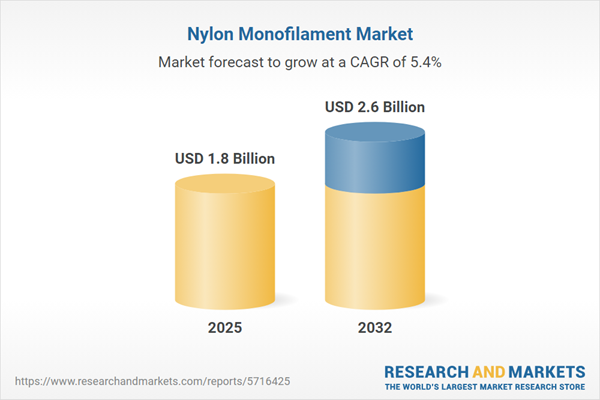Speak directly to the analyst to clarify any post sales queries you may have.
The nylon monofilament market stands as a core component in high-performance sourcing strategies for manufacturers and solution providers. For executives navigating shifting compliance, operational risk, and technological adoption, a deep understanding of this market’s drivers and challenges is essential to strengthening decision-making in competitive sectors.
Market Snapshot: Nylon Monofilament Market Overview
The nylon monofilament market reached USD 1.80 billion in 2025, up from USD 1.71 billion in 2024, maintaining a 5.35% CAGR. Projections indicate further growth to USD 2.60 billion by 2032. This resilient demand is underpinned by applications across agriculture, consumer goods, packaging, electronics, and biomedical industries. Sector evolution is propelled by polymer innovations and enhanced extrusion methodologies. With sustainability taking priority, procurement and investment strategies increasingly reflect environmental targets. Companies throughout the value chain are adjusting operations to align with both regulatory expectations and organizational sustainability goals.
Scope & Segmentation
This report offers detailed analysis to support executive-level performance management and strategic planning in the nylon monofilament market, segmented as follows:
- End Use Industry: Agriculture employs nylon monofilament in crop protection and greenhouse environments. The construction sector requires it for reinforcement and high-filtration applications. In consumer goods, versatility is leveraged for diverse manufactured products. Electronics integrate monofilament for its superior insulation properties. Packaging sectors value its strength and adaptability to evolving logistics needs.
- Product Type: Coated filament delivers rugged performance under harsh conditions. Multi filament grades are selected for flexibility in specialized manufacturing. Single filament variants stand out for robust tensile strength and dimensional stability.
- Diameter Range: Diameters from 0.1-0.2 mm target high-precision uses in medical and electronics, 0.2-0.5 mm covers standard industrial needs, above 0.5 mm supports demanding operations, while below 0.1 mm addresses niche or regulated scenarios.
- Sales Channel: Direct sales drive contract fulfillment for bulk buyers. Dealer networks extend service to region-specific markets. Online specialist channels optimize technical procurement and sourcing efficiency.
- Region: The Americas demonstrate stable demand and application leadership. Europe remains highly responsive to regulatory and technical change. Asia-Pacific rapidly advances with technology adoption and resource intensity. Expansion in the Middle East and Africa coincides with rising uptake of advanced materials and infrastructure growth.
- Leading Companies: Notable sector leaders include Toray Industries, Teijin Limited, Asahi Kasei, Hyosung Corporation, BASF SE, Evonik Industries, Solvay S.A., Arkema S.A., Saudi Basic Industries Corporation, and Koninklijke DSM—each prioritizing R&D, strategic alliances, and tailored solutions for emerging uses.
- Technology Trends: Automated extrusion technologies and sustainable polymer development enable next-level competitiveness, support regulatory compliance, and broaden the market’s industrial reach.
Nylon Monofilament Market: Key Takeaways for Senior Decision-Makers
- Recent advances in polymer science are expanding monofilament applications where demanding safety and technical standards apply, such as electronics assemblies and medical devices.
- Sustainability is core to supplier selection; materials with biodegradable or recyclable characteristics are preferred for supporting holistic supply chain objectives and stakeholder expectations.
- Diversified sourcing and strategic partnerships are increasingly crucial, reducing exposure to regional volatility and optimizing supply chain continuity in a shifting global landscape.
- Production systems increasingly utilize automated controls and digital simulation models, enhancing quality, throughput, and organizational scalability without sacrificing compliance.
- Collaboration among suppliers, OEMs, and technology providers is essential for bringing innovations swiftly into both mainstream and emerging market areas.
- Regional strategies must reflect distinctive technology adoption curves and complex regulatory timelines, especially in Asia-Pacific and Europe, where shifts in policy and production often occur rapidly.
Tariff Impact: Strategic Considerations
In the United States, adjustments to tariffs covering both raw nylon monofilament imports and finished goods directly influence sourcing strategies. Companies are increasingly focusing on domestic manufacturing while targeting procurement in regions benefitting from favorable trade agreements. Enhanced collaboration around cost structures, combined with digital logistics innovation, is supporting efficiency and helping minimize regulatory risks in the supply chain.
Methodology & Data Sources
Analysis in this report relies on interviews with industry experts, comprehensive desk research, and detailed review of regulatory filings and sector-specific trade data. All findings are validated by benchmarking financial and operational data to maximize relevance and credibility for senior management.
Why This Report Matters
- Enables informed capital investment and effective risk strategies through clear segmentation and up-to-date compliance coverage.
- Highlights critical shifts in automation, sustainable sourcing, and digital transformation models suited for manufacturing leaders.
- Provides market intelligence on regional opportunities, evolving policy frameworks, and new pathways for sustainable business growth.
Conclusion
With its unique blend of technical performance and sustainability alignment, nylon monofilament remains a strategic material for forward-thinking organizations. Insights from this report empower executives to fortify operational resilience and advance growth initiatives within evolving regulatory and market ecosystems.
Additional Product Information:
- Purchase of this report includes 1 year online access with quarterly updates.
- This report can be updated on request. Please contact our Customer Experience team using the Ask a Question widget on our website.
Table of Contents
3. Executive Summary
4. Market Overview
7. Cumulative Impact of Artificial Intelligence 2025
List of Figures
Samples

LOADING...
Companies Mentioned
The key companies profiled in this Nylon Monofilament market report include:- Toray Industries, Inc.
- Teijin Limited
- Asahi Kasei Corporation
- Hyosung Corporation
- BASF SE
- Evonik Industries AG
- Solvay S.A.
- Arkema S.A.
- Saudi Basic Industries Corporation
- Koninklijke DSM N.V.
Table Information
| Report Attribute | Details |
|---|---|
| No. of Pages | 186 |
| Published | October 2025 |
| Forecast Period | 2025 - 2032 |
| Estimated Market Value ( USD | $ 1.8 Billion |
| Forecasted Market Value ( USD | $ 2.6 Billion |
| Compound Annual Growth Rate | 5.3% |
| Regions Covered | Global |
| No. of Companies Mentioned | 11 |









